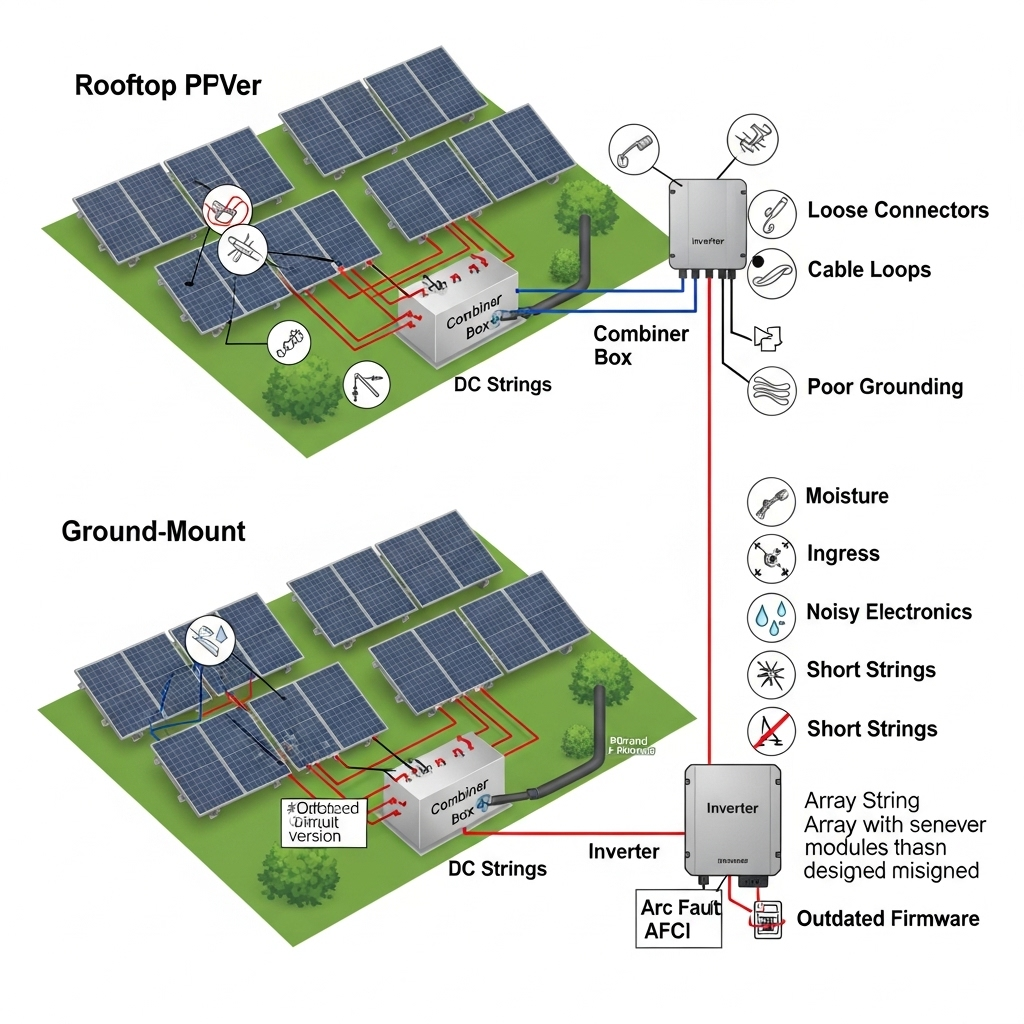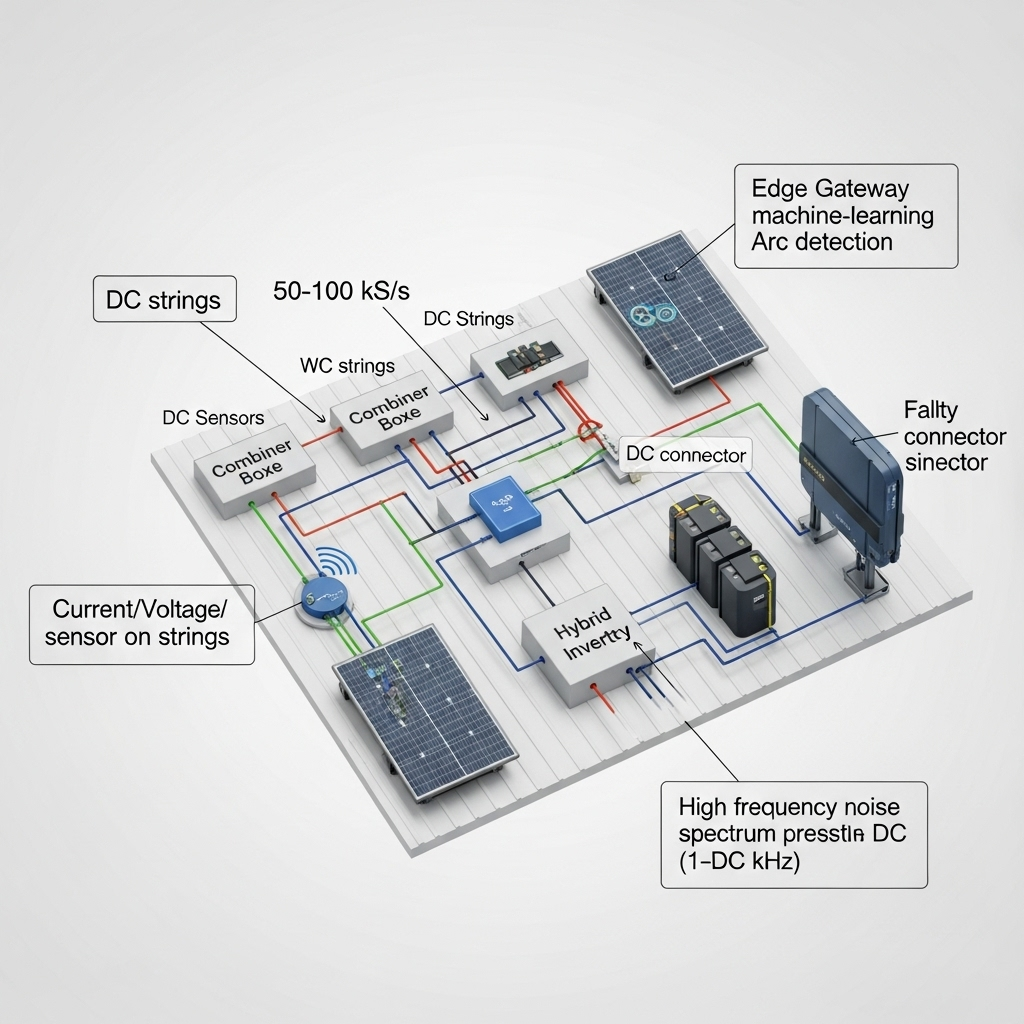False arc-fault trips shut down power, waste service time, and erode confidence in PV systems. Inverters and arc fault circuit interrupters (AFCIs) protect assets, but they can misinterpret noise as a DC arc. Availability drops each time the system trips and rests idle. Industry research notes that reliability measures that prevent unwarranted disconnections preserve availability and revenue. The IEA report on integrating solar and wind highlights protection challenges under high distributed resources, including reduced fault currents and coordination issues that raise the stakes for correct protection settings. The IRENA grid codes guidance recommends validated models, type tests, and periodic in-operation verification to ensure facilities keep performing after updates and repairs. The U.S. Department of Energy underscores the central role of inverters as the interface to the grid, so their protection logic and settings matter for uptime. And as PV output grows each year per the EIA’s solar overview, avoiding nuisance trips becomes a practical reliability goal for every owner.
Why false arc-fault trips happen
PV AFCIs listen for the acoustic-electrical signature of a series arc. Real arcs produce broadband high-frequency content and unstable DC current. But switching devices, long cables, and poor bonding can create similar signatures. As inverter-based resources increase, fault currents are lower and directional, which complicates protection, as noted in the IEA analysis. Good design reduces noise at the source and gives the detector a clean signal.
- DC-side electronics such as rapid-shutdown transmitters and optimizers add switching noise.
- Long, parallel cable runs raise capacitance and coupling. Loops raise inductance and ringing.
- Poor terminations and moisture create intermittent contact and partial discharge.
Safety and compliance notice: Electrical work must follow local codes and standards. Engage a licensed professional for live tests. Content here is technical guidance, not legal advice.
The 7 mistakes that trigger false arc-fault trips
1) Loose, mismatched, or poorly crimped DC connectors
Intermittent contact and micro-gaps can mimic series arcs. Mixed connector families, incorrect crimp tools, or under-torqued glands are common causes.
- Symptoms: Sporadic midday trips, warm connectors, slight browning of housings.
- Mitigation: Use matched connector pairs from the same series, correct dies, and pull-tests. Inspect for discoloration and replace any suspect parts.
2) Cable loops, slack, and poor routing near metal
Large loops and parallel runs increase inductive kick and capacitive coupling. Wires rubbing on frames can add intermittent faults.
- Symptoms: Trips during gusty winds or tracker movement; noise spikes in inverter logs.
- Mitigation: Keep conductors close and tidy, avoid large loops, use UV-rated clips, and maintain edge protection at contact points.
3) String length and combining outside AFCI assumptions
Some AFCI algorithms expect a certain string impedance and cable length. Very short strings, many parallels, or long homeruns can distort signatures.
- Symptoms: Trips after reconfiguring strings or adding a new combiner.
- Mitigation: Stay within the inverter’s recommended string length and parallel count. Add passive filters or re-route homeruns if needed.
4) Noisy electronics: rapid-shutdown, optimizers, and radio sources
Switching at tens of kilohertz can overlap the arc detection band. Poorly placed transmitters and unshielded runs worsen coupling.
- Symptoms: Trips tied to activation of shutdown transmitters or nearby RF equipment.
- Mitigation: Separate control wiring from DC power, use ferrite cores, apply inverter vendor noise filters, and coordinate switching frequencies where allowed.
5) Grounding, bonding, and insulation resistance issues
High-impedance bonds and damaged insulation create leakage and noise. Float conditions change reference points and confuse detectors.
- Symptoms: Trips after rain or dew; megger shows low insulation resistance.
- Mitigation: Verify equipment grounding continuity. Measure insulation resistance to array frame and ground; target values consistent with IEC 62446-1 practices (often ≥1 MΩ at test voltage, environment-dependent). Restore clean bonds and replace degraded cables.
6) Moisture ingress, UV-aged jackets, and junction box faults
Ingress leads to partial discharge and high-frequency noise, especially during morning warm-up.
- Symptoms: Trips shortly after sunrise; visible cracking, chalking, or corroded glands.
- Mitigation: Replace aged leads, re-seal junction boxes to the correct IP rating, and use moisture-blocking glands.
7) Outdated firmware and missing commissioning baselines
Algorithms evolve. Without firmware updates and a baseline fingerprint, sensitivity may be off.
- Symptoms: Newer arrays in the same fleet trip less often; logs show undefined fault codes.
- Mitigation: Update firmware, record clean-day baselines at low, medium, and high irradiance, and adjust sensitivity per the manufacturer’s commissioning guide.
Quick reference: symptoms and fixes
| Mistake | Typical symptom | Primary mitigation |
|---|---|---|
| Loose/mismatched connectors | Midday nuisance trips, warm plugs | Re-terminate with matched parts; verify pull and visual checks |
| Cable loops and poor routing | Trips during wind or tracker motion | Tidy routing; minimize loops; add strain relief and edge guards |
| String configuration outside range | Trips after re-stringing or expansion | Stay within AFCI guidelines; add filters or reroute homeruns |
| Noisy electronics coupling | Trips near RF devices or RSD activation | Separate control and power; ferrites; shielding; coordinate frequencies |
| Grounding/bonding/IR issues | Trips after rain or dew | Restore bonds; insulation tests; replace damaged conductors |
| Moisture ingress and aging | Trips at morning warm-up | Seal boxes; replace cracked jackets; verify IP ratings |
| Outdated firmware/no baseline | Undefined fault codes; fleet inconsistency | Update firmware; capture baseline; tune sensitivity |
Diagnostics that cut false tripping
Start with data
Export inverter and AFCI logs. Note frequency content of events, irradiance, and temperature. Check if trips correlate with wind speed, RSD commands, or tracker movement.
Prove the wiring
- Visual and thermal scan under load. A connector running much hotter than its neighbors is suspicious.
- Continuity, polarity, and insulation resistance tests string by string.
- Temporary isolation of suspect strings to confirm the source.
Control the noise
- Add ferrites at combiner and inverter ends if logs show narrowband peaks.
- Separate control and DC power paths in cable trays.
- Update firmware and re-commission the AFCI baseline.
The IRENA grid codes work emphasizes model validation, simulation tests, and periodic in-operation checks. That approach applies well to AFCIs: validate the system, test after changes, review post-event performance, and correct issues within a reasonable interval. Reduced fault current conditions in inverter-heavy systems, described by the IEA, make this discipline even more important.
Design choices that prevent false trips
- Use consistent connector families, correct crimping tools, and documented torque values.
- Route positive and negative conductors together. Avoid large loops and long parallel runs with other high-frequency lines.
- Select string lengths and homerun gauges that fit the AFCI’s expected impedance window. Confirm with the inverter manual.
- Specify combiner boxes with integrated filtering or space for ferrites if MLPE or RSD is present.
- Document baseline waveforms during commissioning and keep them with O&M records.
Availability loss occurs anytime a system is turned off by a trip or during repairs. Improving components and design to eliminate false trips reduces this loss and improves energy yield, a point reflected in operations literature and consistent with broader reliability goals noted by the U.S. DOE.
Why storage integration and stable DC buses matter
Hybrid systems pair PV arrays with lithium iron phosphate (LiFePO4) batteries and hybrid inverters. A stable DC bus reduces ripple and switching noise. That helps AFCIs avoid false triggers.
Independent summaries of storage performance, such as the Ultimate reference to solar storage performance, consolidate typical industry values like round-trip efficiency and cycle life for LiFePO4. Typical data reported for LiFePO4 include round-trip efficiency around 90–95% and long cycle life at moderate depth-of-discharge. Stable voltage behavior from such packs can lower DC-side noise, improving AFCI discrimination in hybrid setups.
| Storage factor | Common LiFePO4 range | Relevance to false trips |
|---|---|---|
| Round-trip efficiency | ~90–95% (typical) | Higher efficiency reduces current ripple for a given load profile |
| Voltage stability under load | Flat discharge curve | Less DC bus sag and oscillation reduces false signatures |
| Hybrid inverter operation | Coordinated charge/discharge | Smoothed power flow lowers HF content on PV strings |
Teams with years in PV and storage design often integrate LiFePO4 batteries, hybrid inverters, and off-grid solar solutions into coherent ESS. The focus is reliability and scalability so customers gain energy independence without nuisance trips.
Compliance, periodic tests, and model fidelity
The IRENA guidance calls for simulation model specification, verification, and ongoing in-operation monitoring. After installation, firmware updates or maintenance can introduce issues; post-fault performance reviews help catch them. If a facility fails to meet requirements, owners are typically asked to correct within a set time. In distribution systems with high inverter-based resources, legacy protection settings may need updates due to reduced and bidirectional fault currents, as outlined by the IEA. That same rigor should apply to AFCI thresholds and filters in PV plants.
Key takeaways
- Most false arc-fault trips trace to wiring, noise, or configuration, not real arcs.
- Fix connectors, routing, grounding, and firmware first; then tune AFCI thresholds.
- Use periodic testing and baselines to maintain reliability after any change.
- Stable hybrid storage architectures can reduce DC noise and nuisance trips.
Disclaimer: Technical information only. Not legal advice or a substitute for professional engineering judgment.
FAQ
Do PV AFCIs detect a specific frequency band?
Most look for broadband high-frequency content and unstable DC current consistent with series arcs. Exact bands vary by manufacturer, so always check the inverter or combiner documentation.
How can I tell a nuisance trip from a real arc?
Real arcs often leave heat or visible damage at a point in the circuit. Logs may show repeated, escalating events. A nuisance trip has clean visual inspections and often correlates with wind, RF devices, or recent re-stringing.
Will module-level power electronics increase false trips?
They can add switching noise. Good filtering, separation of control lines, and correct firmware settings usually prevent issues. Baseline tests during commissioning help.
How often should I check connectors and torque?
Inspect during annual maintenance and after any major weather event or site work. Replace discolored or heat-damaged parts immediately.
Does adding batteries help with false trips?
A well-integrated LiFePO4 system and hybrid inverter can stabilize the DC bus and reduce noise. That can lower nuisance trip risk, especially during load ramps.





Leave a comment
All comments are moderated before being published.
This site is protected by hCaptcha and the hCaptcha Privacy Policy and Terms of Service apply.